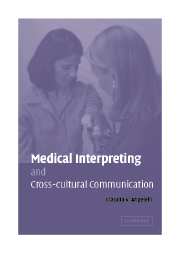Book contents
- Frontmatter
- Contents
- List of figures
- List of tables
- Acknowledgments
- List of abbreviations
- Prologue
- 1 Questioning invisibility
- 2 Communication in the medical encounter
- 3 A different set of lenses
- 4 California Hope: a public hospital in changing times
- 5 Putting it all together
- 6 Finding visibility
- 7 Interpreters' voices
- 8 Emerging metaphors and final words
- References
- Index
Prologue
Published online by Cambridge University Press: 22 September 2009
- Frontmatter
- Contents
- List of figures
- List of tables
- Acknowledgments
- List of abbreviations
- Prologue
- 1 Questioning invisibility
- 2 Communication in the medical encounter
- 3 A different set of lenses
- 4 California Hope: a public hospital in changing times
- 5 Putting it all together
- 6 Finding visibility
- 7 Interpreters' voices
- 8 Emerging metaphors and final words
- References
- Index
Summary
The end of the twentieth century and the beginning of the twenty-first witnessed important changes affecting healthcare delivery to limited-English-speaking patients in the United States. As a result, a gradual emergence of academic questions regarding the nature of communication between healthcare providers and patients across gulfs of language and culture, especially when brokered by interpreters, began to trigger debate as to what roles the interpreters should play. This concern was echoed in practical pleas of interpreters themselves who asked: “What can I do to help, what is my role?”
The field of medical interpreting, in particular, has been undergoing an extraordinary evolution. First, Title VI of the Civil Rights Act of 1964 established the need for professional interpreters, in order to ensure meaningful access to healthcare for patients with limited English proficiency. As a result, government-funded programs for healthcare institutions have been mandated to provide interpreting services to limited-English-speaking patients (Allen 2000). At the same time, medical interpreter organizations are writing and publishing codes of ethics and pursuing certification efforts (California Healthcare Interpreters Association 2002; Massachusetts Medical Interpreters Association 1995). Funding agencies are increasingly paying attention to issues of cross-cultural and linguistic communication. In 2001, the Robert Wood Johnson Foundation funded Hablamos Juntos, an 18-million-dollar national initiative to improve healthcare communication for the Latino population in the United States.
- Type
- Chapter
- Information
- Publisher: Cambridge University PressPrint publication year: 2004

